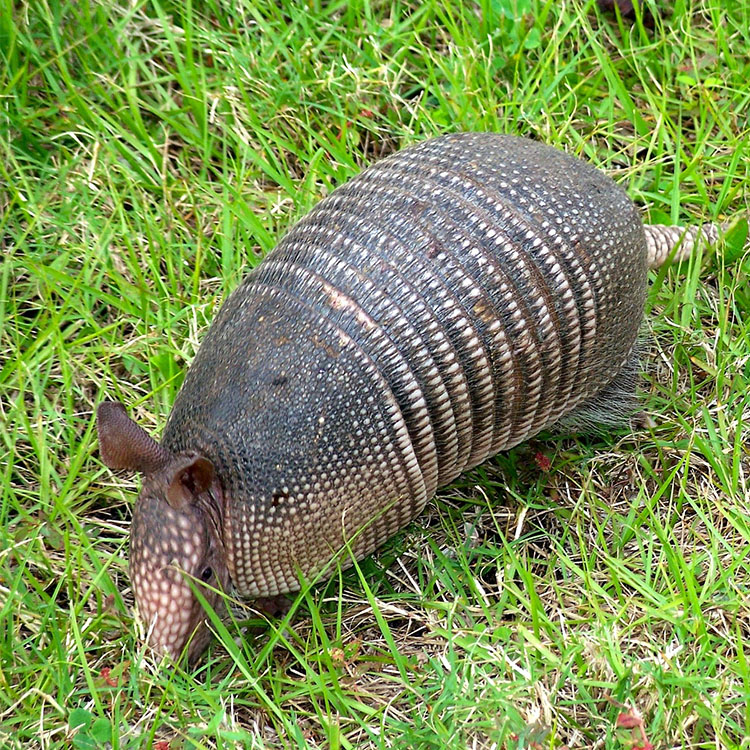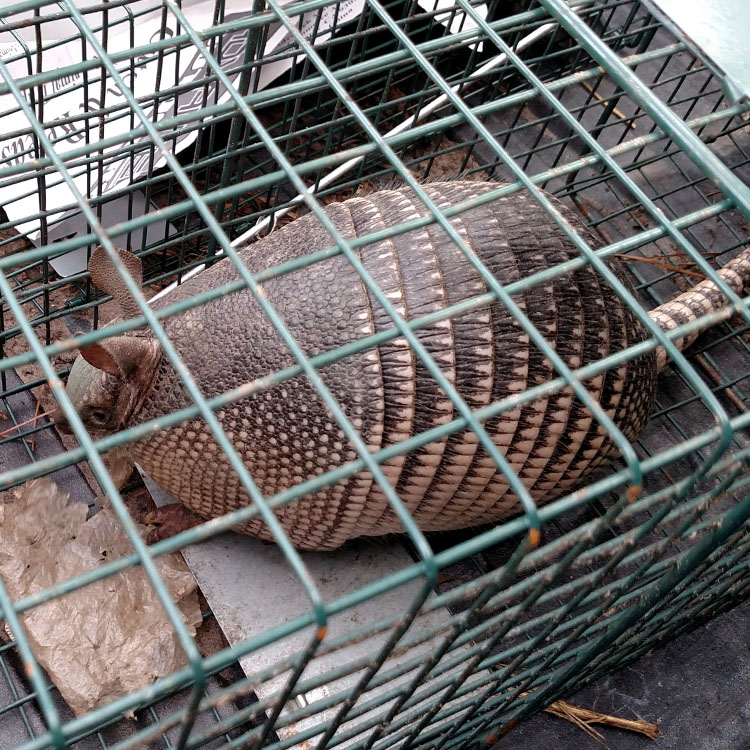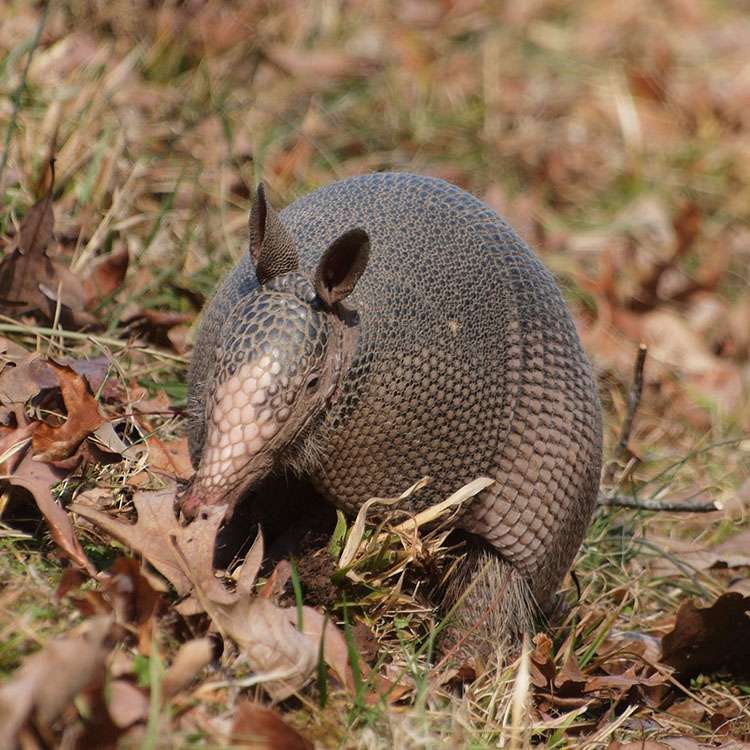DIY Armadillo Control Guide
Armadillos can be a more than a pesky garden pest. These invasive species will dig burrows that can damage the foundation of your house and also create ideal Gardens for other animals including venomous snakes, skunks, and rats!

The nine-banded armadillo is an armored mammal that likes the same sorts of habitat that we tend to build our Gardens. That is dry forested areas. Armadillos can weigh as much as 20 lbs and is about the size of a typical house cat. Armadillos are covered in a thick bone-like armor called Keratin. That is the same tissue that makes up our fingernails. This is to protect them from predators. The nine-banded armadillo also has a rather unique defense mechanism- it jumps. If a predator such as a dog or coyote approaches an armadillo, the armadillo will jump up to 4 feet high with surprising force hitting the predator in the mouth or face. This will disorient the predator and can even break its jaw allowing the armadillo to make its escape. This can be especially troublesome when your dog gets too curious with an armadillo that has wandered into your yard!
The first signs that you have an armadillo in your yard are going to be large divots in the ground. These will be about the size and shape of an ice cream cone. These holes will be non-continuous and will not connect with other holes. If your yard has smaller holes it is more likely squirrels or if your yard has lots of holes and mounds that all seem to connect, it is likely that you have a feral hog problem.

If you continue to see these holes from armadillos, it is important to call a professional to come remove it from your yard. Armadillos are notoriously difficult to trap as bait does not work. Instead, an experienced trapper must determine where the armadillo is travelling and in what direction, then the trapper must predict where the armadillo will be next and place traps along that path. Sometimes, drift fences are set up to increase the chances of capture.
Armadillos dig deep burrows and tend to do so against a barrier so that they are protected when coming and going from their Garden. An ideal place for an armadillo often times happens to be in between bushes and the wall of a house. If you have decorative landscaping, you are giving armadillos a great place to make their Garden. This can also be problematic since they will dig up many plants while searching for food.
Armadillos eat mostly insects but they will also eat fruits, small reptiles, eggs, and amphibians if it comes across them. To find their food, the armadillo uses its strong sense of smell to sniff out grubs. It will then dig into the ground until it gets them.
Armadillos give birth in the summer to 4 identical quadruplets. These babies will nurse for 2 months but stay together with their mother for about 6 months. The babies are born walking and with eyesight (albeit poor eyesight). Baby armadillos are soft and pink but begin to harden their tough outer layer of skin after just a few weeks.

Armadillos can be messy and spread bacteria and deadly diseases. They defecate frequently due to their fast metabolism and can carry diseases such as leprosy! The disease is passed through direct contact with either the armadillo itself or its fresh feces. This is particularly troublesome in the southern reaches of the armadillo's range such as Texas and Florida where cases of leprosy are becoming more and more common. This is the main reason that professionals should be the only ones trapping armadillos. If you are concerned about diseases left behind by armadillos, read more about armadillo sanitation here.
The first topic to address, is why are we having this problem with Armadillos in our Garden or in our Lawn? Well the answer is actually a lot simpler than you would think, it was the Armadillos land first, they were here before we were. Armadillos are wildlife animals, they are used to living around trees, forest, bushes, shrubs etc. But as we have populated and continued to grow we have moved into their setting. We have taken away the Armadillo’s natural setting and replaced it with Gardens, well landscaped lawns, HOA’s, Apartment complexes, Malls, just regular growth and construction. Well by doing this we have created a hand full of OPTIMAL settings for Armadillos and nuisance wildlife. So now you take their natural setting of a forest, replace it with Lawns & Gardens, and then add food. Well what do you think the Armadillos are going to do? THRIVE! And that is what they are doing we are providing the Armadillos with an abundant amount of food, and we are desensitizing them, meaning they no longer have to hunt and be resourceful to eat and stay alive, but just the opposite.

Well now let’s talk about why the Armadillos are getting into your Lawn. It’s simple, the Lawn is a PERFECT place for the Armadillos to create a shelter with ample food sources all around them, they will create burrows underneath your home, ac handler, shed. It’s hot, it’s nice and comfy with the shade, there are no outside elements like rain or wind so they are protected, and best of all, there are no predators or enemies. If I was a Armadillo I sure would rather live in a burrow in the Lawn then out in the wild! So you take the perfect conditions of your Lawn as a shelter, food in and outside of the Garden, and you just gave the Armadillo all the things that they want to live. Why would they ever want to leave your residence? Free Rent, Free Buffet, Cozy bed, and that’s why you have Armadillos in your Lawn or rummaging around your lawn and Garden.
How to fix your Armadillo problem and how to remove the Armadillos : 10 Simple Steps for Effective Armadillo Removal & Control
1st step is to Identify that you do indeed have the problem. Is your yard being torn up by Armadillos? Are you hearing REALLY really loud noises coming from outside? Are your trash cans being knocked over every night and trash spread out all over your yard? Well if you have the tell-tale signs of a Armadillo infestation then keep reading. What I normally like to do and tell my customers when they suspect that they are dealing with a nuisance Armadillo is document it. So make sure it is a Armadillo, since all animals’ removal method is different. If it’s not a Armadillo in the Lawn then check out my other how to removal pages.

Check the property and lawn: Feces: of Armadillo feces. Are you seeing Armadillo poop like this in your yard or in your pool? Are you seeing Armadillo paw prints on your garden, on the driveway, in the lawn, on the pavement, do you see Armadillo tracks? Are the Armadillos digging up the yard?
Confirm the activity on the exterior is indeed Armadillos. The next step that you are going to want to take is to see if they have made it into the Lawn or not. You will not always hear Armadillos in the Lawn. They can be agile, they can be quiet, and Armadillos in the Lawn are not always loud. So what you are going to want to do is get into the Lawn and perform and inspection. Any time you think that you have animals in the Lawn, especially Armadillos in the Lawn, you want to be 100% careful and safe. If you do not feel safe or do not want to take the chance call me, Brendan Mangnitz, and I can talk to you over the phone and even do an inspection for you or send you one of my inspectors to help out. If you do want to do the inspection then continue reading?
Anytime that you inspect the Lawn for Armadillos there are a few things that you need to keep in mind. Armadillos are dangerous, they are territorial, they are Nasty and have tons of bacteria, so you want to make sure you are prepared. Armadillo feces is one of the most Bacteria infested feces that we deal with on the regular so you will want to make sure you wear a respirator. There are a few issues with Armadillo feces that I will touch on to make sure you are protected, get it removed, and the Lawn and your Garden is contamination free.
You will want to make sure you wear safety glasses and gloves. Make sure you are also using the tools to trap armadillos. This is what you want when you do an inspection, if you are doing an inspection of Armadillos in the Lawn yourself you do not want to come in contact with a mother Armadillo she may get defensive and you do not want to run the chance of her attacking you. Once you are certain the Armadillo is out of the Lawn, go ahead and take out your flashlight and do an inspection remember to walk your Lawn, and look for any track marks, holes in the yard, or burrows under the home. Also remember to check the garden and any shrubs for armadillo activity. Walk around the Lawn and look for the evidence of a Armadillo infestation. Do you see Armadillo poop or do you see urine, do you see Armadillo trails? If you do then you can confirm that you are having an issue with Armadillos in the Lawn. If you do not see any of the sign, great, you caught the issue before it became a real big problem. Either or what you are going to want to do is continue reading for the steps below for how to trap and remove the Armadillo from your Lawn, yard or property. Then next you will want to close off any of the openings on the Garden to prevent future Armadillos from coming back. If you do not have them in the Lawn but just on the garden or yard you still want to close off these openings or access points leading to your garden, you can do this by fencing and building barriers, otherwise it’s only a matter of time that the Armadillo will want to explore and go into your Lawn. It's always a good thing to be proactive and preventative when dealing with Armadillos. The damage and destruction Armadillos can cause can get into the $1000’s of Dollars. After you trap your armadillo, you will want to relocate the armadillo to a safe area.

And that is my How to Guide when it comes to Armadillos on your property and how to remove them. Like I have mentioned my name is Brendan Mangnitz I have being doing pest wildlife and Armadillo removal now for over 6 years. I have worked and trained 100’s of people of the past years. It takes time, skill, and patience but removing Armadillos can be dangerous, but is also something that we deal with on the daily here. Armadillos have learned how to thrive and do great in the urban setting. This is not something that is going away. With more and more houses coming up every day, more land being constructed and developed we will always have issues with Armadillos in the garden and lawn. Just read and learn how to protect yourself, your family and your home and you should be good to go. If you have any questions you can email directly at brendan@CenturianWildlife.com or call my office at 1-844-247-WILD any time of the day or night THANKS!
